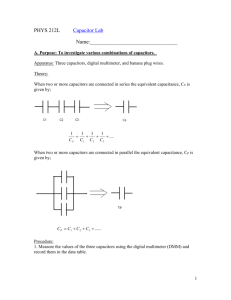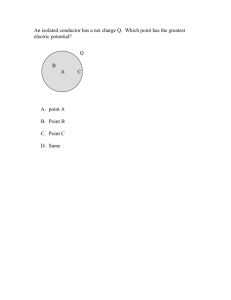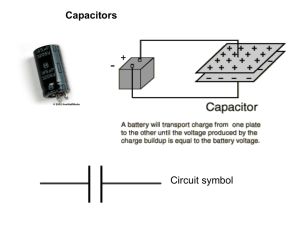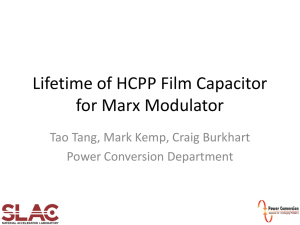Supplementary information (doc 1050K)
advertisement
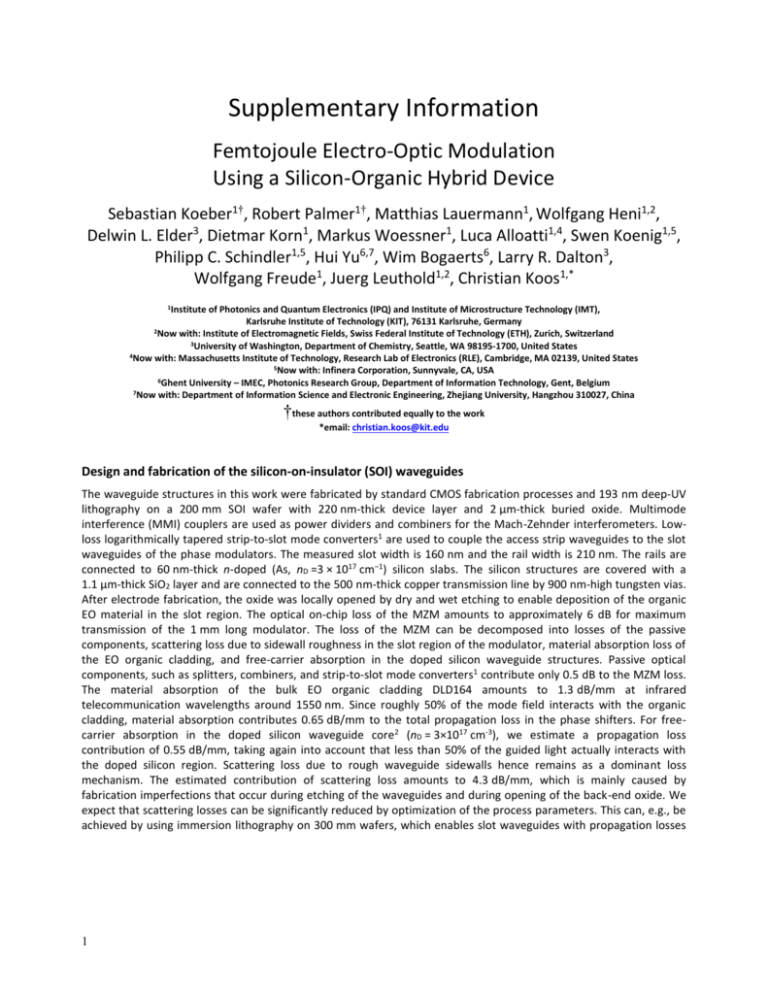
Supplementary Information Femtojoule Electro-Optic Modulation Using a Silicon-Organic Hybrid Device Sebastian Koeber1†, Robert Palmer1†, Matthias Lauermann1, Wolfgang Heni1,2, Delwin L. Elder3, Dietmar Korn1, Markus Woessner1, Luca Alloatti1,4, Swen Koenig1,5, Philipp C. Schindler1,5, Hui Yu6,7, Wim Bogaerts6, Larry R. Dalton3, Wolfgang Freude1, Juerg Leuthold1,2, Christian Koos1,* 1Institute of Photonics and Quantum Electronics (IPQ) and Institute of Microstructure Technology (IMT), Karlsruhe Institute of Technology (KIT), 76131 Karlsruhe, Germany 2Now with: Institute of Electromagnetic Fields, Swiss Federal Institute of Technology (ETH), Zurich, Switzerland 3University of Washington, Department of Chemistry, Seattle, WA 98195-1700, United States 4Now with: Massachusetts Institute of Technology, Research Lab of Electronics (RLE), Cambridge, MA 02139, United States 5 Now with: Infinera Corporation, Sunnyvale, CA, USA 6Ghent University – IMEC, Photonics Research Group, Department of Information Technology, Gent, Belgium 7 Now with: Department of Information Science and Electronic Engineering, Zhejiang University, Hangzhou 310027, China †these authors contributed equally to the work *email: christian.koos@kit.edu Design and fabrication of the silicon-on-insulator (SOI) waveguides The waveguide structures in this work were fabricated by standard CMOS fabrication processes and 193 nm deep-UV lithography on a 200 mm SOI wafer with 220 nm-thick device layer and 2 μm-thick buried oxide. Multimode interference (MMI) couplers are used as power dividers and combiners for the Mach-Zehnder interferometers. Lowloss logarithmically tapered strip-to-slot mode converters1 are used to couple the access strip waveguides to the slot waveguides of the phase modulators. The measured slot width is 160 nm and the rail width is 210 nm. The rails are connected to 60 nm-thick n-doped (As, nD =3 × 1017 cm‒1) silicon slabs. The silicon structures are covered with a 1.1 µm-thick SiO2 layer and are connected to the 500 nm-thick copper transmission line by 900 nm-high tungsten vias. After electrode fabrication, the oxide was locally opened by dry and wet etching to enable deposition of the organic EO material in the slot region. The optical on-chip loss of the MZM amounts to approximately 6 dB for maximum transmission of the 1 mm long modulator. The loss of the MZM can be decomposed into losses of the passive components, scattering loss due to sidewall roughness in the slot region of the modulator, material absorption loss of the EO organic cladding, and free-carrier absorption in the doped silicon waveguide structures. Passive optical components, such as splitters, combiners, and strip-to-slot mode converters1 contribute only 0.5 dB to the MZM loss. The material absorption of the bulk EO organic cladding DLD164 amounts to 1.3 dB/mm at infrared telecommunication wavelengths around 1550 nm. Since roughly 50% of the mode field interacts with the organic cladding, material absorption contributes 0.65 dB/mm to the total propagation loss in the phase shifters. For freecarrier absorption in the doped silicon waveguide core2 (nD = 3×1017 cm-3), we estimate a propagation loss contribution of 0.55 dB/mm, taking again into account that less than 50% of the guided light actually interacts with the doped silicon region. Scattering loss due to rough waveguide sidewalls hence remains as a dominant loss mechanism. The estimated contribution of scattering loss amounts to 4.3 dB/mm, which is mainly caused by fabrication imperfections that occur during etching of the waveguides and during opening of the back-end oxide. We expect that scattering losses can be significantly reduced by optimization of the process parameters. This can, e.g., be achieved by using immersion lithography on 300 mm wafers, which enables slot waveguides with propagation losses 1 of less than 1 dB/mm, see ref. 3. Similarly, for 200 mm technology, propagation losses below 0.7 dB/mm have been demonstrated4 by exploiting a larger slot width of 190 nm. Further reduction is possible by deploying asymmetric slot geometries, where losses of 0.2 dB/mm have been demonstrated5. Using these techniques and reducing the device length, on-chip modulator losses between 1 dB and 2 dB should be feasible in future device generations. Electro-optic cladding The nonlinear chromophore DLD164 is applied to the chip by spin coating from a solution of 1,1,2-trichloroethane. Before spin-coating, the solution is exposed to ultrasonic agitation and is subsequently filtered through a membrane filter. The chip is baked under vacuum prior to poling. The material is poled in push-pull orientation at glass-transition temperature by applying a DC voltage across the floating ground electrodes of the transmission line as described in Fig. 1(b) and Ref 6. The refractive index of DLD164 has been measured by ellipsometry7 on various material samples. At a wavelength of 1546 nm, the refractive index ranged from n = 1.78 to n = 1.83, depending on the sample. The molecular weight of the DLD164 chromophore is Mw(DLD164) = 1523 g/mol. According to the colour scheme in Fig. S1, the electro-optic chromophore core (red) accounts for 705 g/mol (46%), and the side-groups (blue) account for 818 g/mol (54%). Each molecule in the cladding contains one chromophore, thus 1 g of neat DLD164 cladding material contains 6.57 x 10-4 mol chromophores. In the case of YLD124 (molecular weight Mw(YLD124) = 880 g/mol) the final cladding material contains 75 wt.% PMMA, thus 1 g of YLD124/PMMA contains 0.25 g of YLD124, which corresponds to 2.84 x 10-4 mol chromophores. The molar ratio Mw(DLD164)/ Mw(YLD124) is 2.31. Since the mass density of both materials can be considered identical7, this ratio corresponds as well to the ratio of chromophore number density N in the slot volume. Evaluation of the electro-optic coefficient r33 The EO coefficient of the organic cladding material that fills the slot waveguide can be estimated from the -voltage U of a push-pull MZM, using the expression8,9: wslot c , (1) r33 3 2LU nslot where c is the carrier wavelength, wslot is the width of the silicon slot, L is the modulator length, nslot is the refractive index of the EO material in the slot, and is the field interaction factor. The interaction factor is calculated from the electric mode field Ex of the optical slot-waveguide using the expression8,9 E x d Aslot nslot slot , (2) Z0 2P (c ) where P is the power of the mode field, ωc the frequency of the optical carrier and Z0 is the impedance of free space. For the waveguide geometry in this work and the refractive index of DLD164 nslot = 1.83, we calculate a field interaction factor of 0.21 0.02 . The uncertainty of is a result of limited accuracy when measuring the device 2 dimensions. The reported values of r33 were calculated using the mean value 0.21 . 2 Fig. S1 Chemical structure of the electro-optic chromophores DLD164 (a) and YLD124 (b), respectively. The electro-optic active parts are highlighted in red colour. The molecular structure of the active segments of DLD164 and YLD124 is identical except for differences in the solubilizing head group on the donor part of each molecule. Since these groups are decoupled from the conjugated system, they do not have any substantial influence on the hyperpolarizability zzz of the molecule and can thus be neglected. Fig. S2: Lumped-element equivalent-circuit model of the VNA measurement, valid for RF wavelengths that are much larger than the modulator length. The reflection factor S11 of the non-terminated device is measured. The device impedance Zd and the device capacitance Cd are extracted from the S11 parameter Data transmission experiment The experimental setup is depicted in Fig. 3 (a). We use laser light at 1546 nm with a typical power of 5 dBm and controlled polarization, which is coupled to the DUT using on-chip grating couplers10. Light is modulated by coupling the signal of a pseudo-random bit pattern generator (PPG) to the coplanar transmission line of the modulator using a GSG RF probe. The pattern sequence length amounts to 231-1. Electrical signals are coupled to the chip by using standard RF probes (GGB Industries, Picoprobe). For high data rates, a second RF probe is used to terminate the transmission line. A bias voltage of 2 V is applied to the GSG electrodes using a bias-T. The modulated light is amplified by an erbium doped fibre amplifier (EDFA) and then received by a digital communications analyzer (DCA) and a bit error ratio tester (BERT). The output power of the EDFA is kept at constant value of approximately 13 dBm throughout the measurements. A gate field of up to 250 V/µm is applied between modulator and substrate for increasing the conductivity of the silicon as explained in Ref. 11. 3 Modulator capacitance measurement For a non-terminated device, the device capacitance can be extracted from the complex frequency-dependent amplitude reflection factor S11 at the device input. The input impedance Zd is linked to S11 by Z d () ZL 1 S11 () , 1 S11 () (3) where ZL = 50 Ω denotes the impedance of the RF feed line. The frequency-dependence of S11 can be measured by using a vector network analyzer (VNA) and performing a reflection factor measurement. A calibration substrate is used for reference measurements, thereby taking into account all the parasitics of the feed lines and the RF probe. For low frequencies, the modulator is much shorter than the operating radio-frequency (RF) wavelength and can be treated as a “lumped” element. As a simple model, we assume an equivalent circuit which only comprises a series resistor Rd and a capacitor Cd, as depicted in Fig. S2. The device impedance can then be written as 1 . (4) Zd Rd jC d For a 1 mm-long device, this approximation holds up to approximately 10 GHz, and the device capacitance Cd can directly be extracted from the frequency-dependent imaginary part of the measured device impedance, see blue trace in Fig. S3(a). Note that the device capacitance depends on frequency since the silicon slot is filled with a dispersive dielectric. A simple model function based on the capacitance of a parallel-plate capacitor, C fit òr ( f ) D , is then fitted to the measured data, where òr ( f ) is the known permittivity function of the electro-optic organic material and D is the only fitting parameter. The fit is represented by the dashed green trace in Fig. S3(a). This way, the capacitance can be extrapolated even for frequencies exceeding 10 GHz. Capacitance measurements have been repeated for devices of different length, see Fig. S3(b). As expected, the relation between capacitance and length is linear. In addition, we confirm the measured capacitance by an electrostatic simulation using the commercial simulation software CST Microwave Studio, leading to a value of 402 fF for a 1 mm-long device at a frequency of 40 MHz. This is in good agreement with the corresponding value of 436 fF as obtained from fitting the measurement results. The capacitance has furthermore been measured at a frequency of 1 MHz using an LCR-meter and is found to deviate by only 16 % from the extrapolation of the VNA measurements to low frequencies. We thus conclude that the device capacitance Cd was estimated with reasonable accuracy. Fig. S3: Measurement of device capacitance Cd. (a) Measured capacitance of a 1 mm-long MZM (blue) as a function of frequency and fitted function (green dashed curve). (b) Measured device capacitance for different device lengths at 10 GHz extracted from the respective fits. A linear relation between capacitance and length is confirmed. 4 Estimation of energy consumption Travelling-wave modulator with 50 Ω termination In the following, we assume signals with ideally rectangular non-return-to-zero (NRZ) pulse shapes, featuring a defined peak-to-peak voltage of Udrive at the input of the device. For the travelling-wave modulators, the coplanar transmission line is matched to a 50 source impedance and terminated by matched load resistor RL = 50 , see Fig. 3(d) of the main paper for an equivalent-circuit model of the device and of the RF source. The RF power is then dissipated along the lossy transmission line and in the termination, and the energy per bit Wbit is obtained by dividing the dissipated power by the data rate r, Wbit = (Udrive / 2)2 / (RL ×r) . For the terminated device, the drive voltage Udrive is measured directly by replacing the 50 -terminated device by an oscilloscope with 50 input impedance. According to the equivalent circuit in Fig. 3(d) the drive voltage is half the value of the open circuit voltage U0 of the source. Lumped-element device without termination The energy consumption of a non-terminated device is dominated by power dissipation in the series resistances RS and Rd when charging and de-charging the device capacitor Cd, see Fig. 3(e) of the main paper for an equivalent-circuit model. The dissipated energy depends on both the drive voltage and the device dynamics. In the following, we derive three different methods for estimating the power dissipation of the non-terminated device: In a simple model (Method 1), the energy consumption of a single switching process is estimated by assuming a step-like drive signal which fully charges the capacitor12. This method is only valid for data rates far below the RC cut-off frequency of the device. A more general, but also more complex frequency-domain model (Method 2) allows to estimate the energy consumption also for high data rates and frequency-dependent device parameters. A simple but still reasonably accurate model (Method 3) can be obtained by combining the time-domain analysis according to Method 1 with a frequency-domain transfer function similar to the one used in Method 2. We show that all three methods exhibit comparable results when applied to the devices presented in the main paper, thereby indicating the reliability of the estimated energy consumption. In the limit of low data rates, the methods give identical results. For our analysis, we represent the device by a lumped-element equivalent circuit according to Fig. S4(a). Moreover, unless otherwise noted, we assume bipolar rectangular drive signals, which vary between voltage levels of -U0/2 and +U0/2, Figs. S4(b) and (c). It has been shown in Ref. 12 that the drive circuit can be designed to operate the device at any DC bias without additional power dissipation. Hence, the results derived below are also valid for NRZ drive signals, ranging from 0 to U0, hence having a non-zero DC component of U0/2. Method 1: Time-domain analysis for data rates far below the RC cut-off frequency For Method 1, we consider a step-like drive signal which fully charges the capacitor from an initial level of -U0/2 to a final level of +U0/2, see Fig. S4(b) 12. The signal source and the device form an RC-circuit, for which the series resistance R= Rs + Rd is given by the sum of the internal source resistance Rs and the device resistance Rd. For a single charging process the energy dissipated in the series resistors Wr amounts to12 1 (5) Wr CdU02 . 2 Note that this expression is independent of the value of the series resistance R. Charging and de-charging occurs statistically every second bit of our pseudo-random bit sequence. Therefore the energy consumption per bit is given by12 1 1 Wbit Wr / 2 CdU02 CdUc2 . (6) 4 4 Here, Uc is the voltage at the capacitor, and both quantities, Uc and U0 are to be understood as peak-to-peak voltages. Note that Eq. (6) is only valid in the limit of low data rates, for which the capacitor is fully charged or de-charged during the time slot of one symbol. It is therefore not clear how accurate the results of this analysis are when applied to our device, which is operated close to its RC cut-off frequency and in addition features a frequency-dependent device capacitance, see Fig. S3(a). 5 Fig. S4 Charging and de-charging of the device capacitor Cd. (a) Equivalent circuit. U0 denotes the open-circuit voltage of the source, and Udrive denotes the drive voltage at the input of the device. The quantities Uc and Ur denote the voltage drops across the device capacitor Cd and the series resistor R = Rs + Rd, respectively. (b) Rectangular drive signal (black) and resulting capacitor voltage (blue) for a data rate below the RC cut-off frequency. The device capacitor can be fully charged during the timeslot of one symbol. We assume bipolar rectangular drive signals, which vary between voltage levels of -U0/2 and +U0/2. (c) Rectangular drive signal (black) and resulting capacitor voltage (blue) for a data rate close to the RC cut-off frequency. The device capacitor is no longer fully charged within the timeslot of one symbol. As a consequence, the voltage change Uc < U0 across the slot capacitor varies from symbol to symbol. Method 2: General frequency-domain analysis To account for limited RF bandwidth and frequency-dependent device parameters, we consider a frequency-domain device model, which is also based on the equivalent circuit depicted in Fig. S4(a). According to the Wiener-Khintchinetheorem, the voltage power spectral density 0 ( f ) of the pseudo-random source signal u0 (t ) is given by the Fourier transform of the signal’s autocorrelation function uu ( ) , 0 ( f ) uu ( )e j2 f d , uu ( ) u0 (t)u0 (t )dt . (7) Assuming equal probabilities of ones and zeros, the voltage power density 0 ( f ) of a bipolar rectangular drive signal with peak-to-peak voltage U0 has the form13 2 U sin( fT ) 0 ( f ) 0 T , 2 fT 2 where 1/T is the symbol rate and where 0 ( f ) fulfils 6 (8) 2 U0 (9) 0 ( f )df 2 . From the voltage power spectrum 0 ( f ) at the source, we can calculate the voltage power spectrum r ( f ) at the series resistor R, r f Hr ( f ) 0 f , 2 (10) 2 where Hr ( f ) is the respective power transfer function, derived from the voltage-divider relationship Hr ( f ) 1 . 1 1 j 2 fRC d (11) The physical power that is dissipated in the series resistor R = Rs+Rd can then be calculated by 1 Pr r f d f . R (12) The average energy consumption per bit Wbit is obtained by multiplying the average dissipated power by the symbol duration T, T 2 Wbit PT H( f ) 0 ( f )d f r R 2 2 (13) T2 U 1 sin( fT ) 0 d f . R 2 1 1 4 2 f 2R2Cd2 fT This expression represents the energy consumption of a non-terminated modulator for arbitrary data rates. Note that the device capacitance Cd may be a frequency-dependent quantity, e.g., in consequence of a frequency-dependent dielectric constant òr ( f ) as explicitly shown for the SOH modulator in Fig. S3(a). This is directly taken into account in Eq. (13) when substituting Cd by a frequency-dependent capacitance Cd(f). When assuming a frequency-independent device capacitance Cd and symbol rates 1/T far below the RC cut-off frequency, we can show that Eq. (13) is equivalent to the result of the simplified time-domain model, Eq. (6). With RCd , Eq. (13) takes the form Wbit T 2 U0 2 R 2 T U0 R 2 2 T U0 R 2 2 2 2 sin(T / 2) 1 1 2 2 T / 2 d 1 sin (T / 2) T / 2 T / (2 ) dT / 2 2 2 2 (14) 2 e T T 2 T sinh 2 T U 0 1 e . R 2 Inserting RCd leads to the compact expression 2 T 1 Wbit CdU02 1 e . 4 7 (15) Operating the device close to the cut-off frequency hence reduces power dissipation in the series resistor. For T , this relation converges to the expected expression of Eq. (6) T 1 CdU02 . (16) 4 The simplified time-domain model of Method 1 can hence be understood as a special case of the general frequencydomain model according to Method 2. Wbit Method 3: Time-domain approximation for high data rates For operation close to the RC cut-off frequency, the capacitor is no longer fully charged or de-charged within the timeslot of one symbol. As a consequence, the capacitor voltage Uc is smaller than the open-circuit source voltage U0. For estimating the associated power consumption, let us consider the case where the source voltage changes from an initial value of -U0/2 to a value of U0/2 at t = t1, see first symbol in Fig. S4(c). In the subsequent symbol slot, the capacitor voltage changes from –UC/2 to UC/2. Following the derivation in Ref.12, the energy dissipated in the series resistor R during the subsequent symbol slot is then given by t1 T Uc /2 U 1 Wr ur t ir t dt C d 0 uC duC C dUcU0 . (17) t1 Uc /2 2 2 The energy consumption of the modulator is then given by 1 Wbit CdUcU0 . 4 (18) This expression also converges to Eq. (6) for T since Uc U0 in this case. Thus, the capacitor voltage Uc and the device capacitance Cd determine the energy consumption. However, the capacitor voltage Uc at the end of each symbol slot is varying depending on the sequence of symbols, see Fig. S4(c). For an approximate estimate of the energy consumption, we replace the peak-to-peak capacitor voltage Uc by twice its respective effective voltage Uc 2Uceff , as would be the case for a perfect mean-free rectangular signal. The effective capacitor voltage Uceff is derived from the corresponding voltage power spectral density at the capacitor c ( f ) , Uceff c ( f )d f . (19) The quantity c ( f ) can be calculated from the source power spectral density 0 ( f ) by making use of the voltage divider formula 2 c ( f ) Hc ( f ) 0 ( f ) , (20) 2 where the power transfer function Hc ( f ) is given by Hc ( f ) 1 . 1 j2 fRCd (21) Assuming a frequency-independent capacitance, the energy consumption of the modulator can then be calculated by inserting Eq. (19), Eq. (20), Eq. (21), and the relation Uc 2Uceff into Eq. (18). 8 Comparison of the three methods The three methods for calculating the energy consumption yield similar results when applied to a 1 mm-long SOH MZM operated at four different rata rates of 0.5 Gbit/s, 2.5 Gbit/s, 12.5 Gbit/s, and 20 Gbit/s. For calculating the energy consumption according to Method 2, we use the frequency-dependent capacitance of the modulator as depicted in Fig. S3(a). The device resistance Rd is extracted from the real part of the measured input impedance and is found to be Rd 18 . Table S1 summarizes the results of the comparison. The second column shows the calculated mean capacitor voltage according to Eq. (19). The mean capacitor voltage Uc is approaching the full open circuit voltage U0 for small data rates, while it can be significantly lower than U0 for data rates approaching the 3-dB cut-off frequency. The last three columns show the energy consumptions that were estimated by the previously described three methods. For the calculation according to Method 1, we neglect the frequency dependence of the device capacitance and use its mean value of Cd = 392 fF. The energy per bit Wbit is thus given by Eq. (6) and is independent of the data rate r = 1/T. For Method 2, we insert the measured frequency-dependent device capacitance into Eq. (13), and we take into account the RC limitations of the device. Method 3 also takes into account the RC limitations of the device, but the frequency dependency of the device capacitance is omitted and a constant value of Cd = 392 fF is used for the calculation. The energy-per-bit values calculated by Method 2 and Method 3 are generally decreasing with increasing data rate r. Method 1, in contrast, over-estimates the calculated energy consumption by 10% to 20% for data rates close to the cut-off frequency. As expected, for low data rates all three methods provide identical results, since the drive voltage approaches U0 and the capacitor is fully charged. Given this agreement, we conclude that the proposed methods for calculating the effective energy consumptions are valid and accurate. The energy consumption values shown in the main article were calculated based on Eq. (13) of method 2, since this method also takes into account the frequency-dependency of the device capacitance and is therefore expected to produce the most accurate results. Table S1 – Calculated drive voltage and energy consumption of a non-terminated 1 mm-long modulator for four different data rates. The modulator resistance is measured to be Rd 18 . UC 2UCeff Wbit - Method 1 Wbit - Method 2 Wbit - Method 3 r = 0.5 Gbit/s, 397 mV 15.7 fJ 15.7 fJ 15.6 fJ U0 = 400 mV r = 2.5 Gbit/s, 386 mV 15.7 fJ 15.7 fJ 15.1 fJ U0 = 400 mV r = 12.5 Gbit/s, 329 mV 15.7 fJ 14.6 fJ 12.9 fJ U0 = 400 mV r = 20 Gbit/s, 294 mV 15.7 fJ 12.9 fJ 11.5 fJ U0 = 400 mV r = 12.5 Gbit/s, 74 mV 0.8 fJ 0.7 fJ 0.7 fJ U0 = 90 mV 9 Calculation of the effective drive voltage In our experiment, terminated and non-terminated devices are operated with various different drive voltages Udrive. The drive voltage Udrive is defined as the voltage which drops across both the device resistor Rd and the device capacitor Cd, see Fig. S4(a). These drive voltages depend both on the device parameters and on the operating frequency. Assuming rectangular mean-free signals, the drive voltage can be estimated as twice the effective input voltages in analogy to Eq. (19), eff Udrive 2Udrive 2 drive ( f )d f . (22) The drive voltage power spectral density drive ( f ) can be calculated from the source spectral density 0 ( f ) 2 drive ( f ) Hdrive ( f ) 0 ( f ) (23) using the transfer function 1 j2 fRdCd . (24) 1 j2 fRCd Eq. (22) is used to calculate the drive voltages that define the x-axis of Fig. 3(b) and (c) of the main article. For the 250 µm long MZM and for a data rate of 40 Gbit/s, we find a mean drive voltage of Udrive = 0.84 U0 , and the same ratio is obtained for the 1 mm long MZM operated at a data rate of 12.5 Gbit/s. In the experiment, the mean drive voltage is determined by measuring half of the open-circuit voltage of the generator with a 50 -terminated scope (Uscope = U0/2) and by multiplying U0 with the calculated factor of 0.84. Hdrive ( f ) References 1 Palmer R, Alloatti L, Korn D, Heni W, Schindler PC, Bolten J et al. Low-loss silicon strip-to-slot mode converters. IEEE Photon J 2013; 5: 2200409–2200409. 2 Soref R, Bennett B. Electrooptical effects in silicon. IEEE J Quantum Electron 1987; 23: 123–129. 3 Selvaraja SK, Murdoch G, Milenin A, Delvaux C, Ong P, Pathak S et al. Advanced 300-mm waferscale patterning for silicon photonics devices with record low loss and phase errors. In: 17th Opto-Electronics and Communications Conference (OECC-2012). IEEE, 2012, pp 15–16. 4 Ding R, Baehr-Jones T, Kim W-J, Xiong X, Bojko R, Fedeli J-M et al. Low-loss strip-loaded slot waveguides in Siliconon-Insulator. Opt Express 2010; 18: 25061. 5 Ding R, Baehr-Jones T, Kim W-J, Boyko B, Bojko R, Spott A et al. Low-loss asymmetric strip-loaded slot waveguides in silicon-on-insulator. Appl Phys Lett 2011; 98: 233303. 6 Palmer R, Alloatti L, Korn D, Schindler PC, Baier M, Bolten J et al. Low power Mach-Zehnder modulator in siliconorganic hybrid technology. IEEE Photon Technol Lett 2013; 25: 1226–1229. 7 Elder DL, Benight SJ, Song J, Robinson BH, Dalton LR. Matrix-assisted poling of monolithic bridge-disubstituted organic NLO chromophores. Chem Mat 2014; 26: 872–874. 8 Brosi J-M, Koos C, Andreani LC, Waldow M, Leuthold J, Freude W. High-speed low-voltage electro-optic modulator with a polymer-infiltrated silicon photonic crystal waveguide. Opt Express 2008; 16: 4177. 9 Witzens J, Baehr-Jones T, Hochberg M. Design of transmission line driven slot waveguide Mach-Zehnder interferometers and application to analog optical links. Opt Express 2010; 18: 16902. 10 Taillaert D, Van Laere F, Ayre M, Bogaerts W, Van Thourhout D, Bienstman P et al. Grating couplers for coupling between optical fibers and nanophotonic waveguides. Jpn J Appl Phys 2006; 45: 6071–6077. 11 Alloatti L, Korn D, Palmer R, Hillerkuss D, Li J, Barklund A et al. 42.7 Gbit/s electro-optic modulator in silicon technology. Opt Express 2011; 19: 11841. 10 12 Miller DAB. Energy consumption in optical modulators for interconnects. Opt Express 2012; 20: A293. 13 Bishop DF, Million S, Nguyen TM, Simon MK. Power Spectrum of Unbalanced NRZ and Biphase Signals in the Presence of Data Asymmetry. IEEE Trans Electromagn Compat 1998; 40: 55–61. 11


